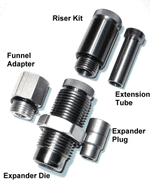- Messages
- 297
- Reactions
- 75
I bolted that failsafe mechanism on the bottom of the powder measure together, and wrapped a spring around the powder measure funnel, and the thingy on the powder bar. Works awesome. I never show a .1 grain difference. If I do see a difference at all, I clean the expander funnel, and swab it with a bit of bounce then it's perfect again for a few more thousand loads. I'm sure it's me, but I found the clunky failsafe system to be super annoying. The spring works awesome. I backup my method with a hornady powder cop die.












